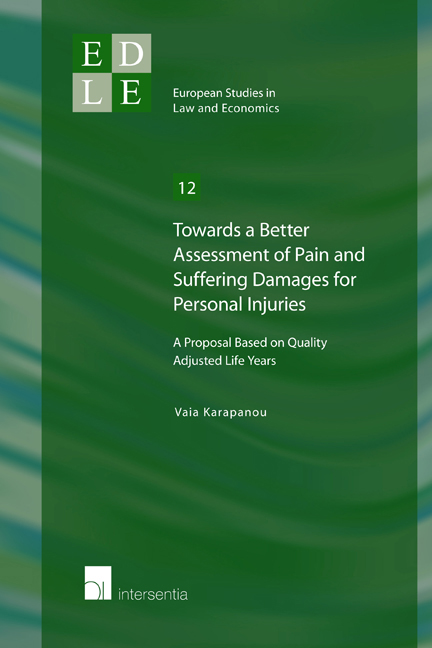 Towards a Better Assessment of Pain and Suffering Damages for Personal Injuries
Towards a Better Assessment of Pain and Suffering Damages for Personal Injuries Book contents
- Frontmatter
- Acknowledgements
- Contents
- Table of Cases
- List of Abbreviations
- List of Tables and Figures
- Chapter 1 Introduction
- Chapter 2 How Should Pain and Suffering Damages be Assessed? A Legal Perspective
- Chapter 3 How Should Pain and Suffering Damages be Assessed? A Law and Economics Perspective
- Chapter 4 Quality Adjusted Life Years. A Measure for the Economic Evaluation of Health Care
- Chapter 5 Using QALYs in a Tort Law Context. Assessing Pain and Suffering Damages
- Chapter 6 Pain and Suffering Damages Based on QALYs. Circumventing Victims' (and Judges') Hedonic Misperceptions
- Chapter 7 The QALY Framework Applied. Practical Examples and Implementation Recommendations
- Chapter 8 Epilogue
- Bibliography
- About the author
- EUROPEAN STUDIES IN LAW AND ECONOMICS
Chapter 5 - Using QALYs in a Tort Law Context. Assessing Pain and Suffering Damages
Published online by Cambridge University Press: 22 November 2017
- Frontmatter
- Acknowledgements
- Contents
- Table of Cases
- List of Abbreviations
- List of Tables and Figures
- Chapter 1 Introduction
- Chapter 2 How Should Pain and Suffering Damages be Assessed? A Legal Perspective
- Chapter 3 How Should Pain and Suffering Damages be Assessed? A Law and Economics Perspective
- Chapter 4 Quality Adjusted Life Years. A Measure for the Economic Evaluation of Health Care
- Chapter 5 Using QALYs in a Tort Law Context. Assessing Pain and Suffering Damages
- Chapter 6 Pain and Suffering Damages Based on QALYs. Circumventing Victims' (and Judges') Hedonic Misperceptions
- Chapter 7 The QALY Framework Applied. Practical Examples and Implementation Recommendations
- Chapter 8 Epilogue
- Bibliography
- About the author
- EUROPEAN STUDIES IN LAW AND ECONOMICS
Summary
The preceding detailed description of the QALY, although far from being complete, aimed to show that the QALY is a reliable measure of the quality and duration of life that has resulted from and is supported by thorough scientific research. The previous analysis emphasized the QALY's strengths and weaknesses in the context of the economic appraisal of health care programs and interventions, where it has been used so far. The ability of QALYs to represent the consequences of different health treatments and interventions in terms of morbidity and mortality in a relatively simple manner has led many researchers to recognize the QALY as the best method currently available to assist the allocation of health care resources, although this assertion has not been uncontested. Taking advantage of these characteristics, the current chapter revisits the problem underlying the assessment of pain and suffering damages for personal injuries, offering a solution that is based on an alternative use of the QALY.
As explained previously in chapter 2, the problem with the assessment of pain and suffering damages, as it is currently performed in most of the countries examined, is that it lacks a framework which can take into account the relative consequences of different types of injuries on the remaining life expectancy and the health and quality of life of the victim and translate them into monetary awards. The result is that damages awarded may be unpredictable and not reflect the gravity of the immaterial loss incurred. Under these circumstances it is doubtful whether the amounts granted can provide fair compensation to the victim, and offer appeasement for her loss. Analogous negative repercussions are generated from current assessment practices for deterrence and loss spreading. To deter potential tortfeasors, the magnitude of pain and suffering damages should depend on the gravity of the losses and be easily expected to induce individuals to take precautions. Similarly, to ensure that liability insurance is sustainable and encourage its provision and purchase, the size of pain and suffering damages should be verifiable ex ante to allow incorporation of the losses into the premiums and product/service prices offered.
- Type
- Chapter
- Information
- Towards a Better Assessment of Pain and Suffering Damages for Personal InjuriesA Proposal Based on Quality Adjusted Life Years, pp. 117 - 146Publisher: IntersentiaPrint publication year: 2014


